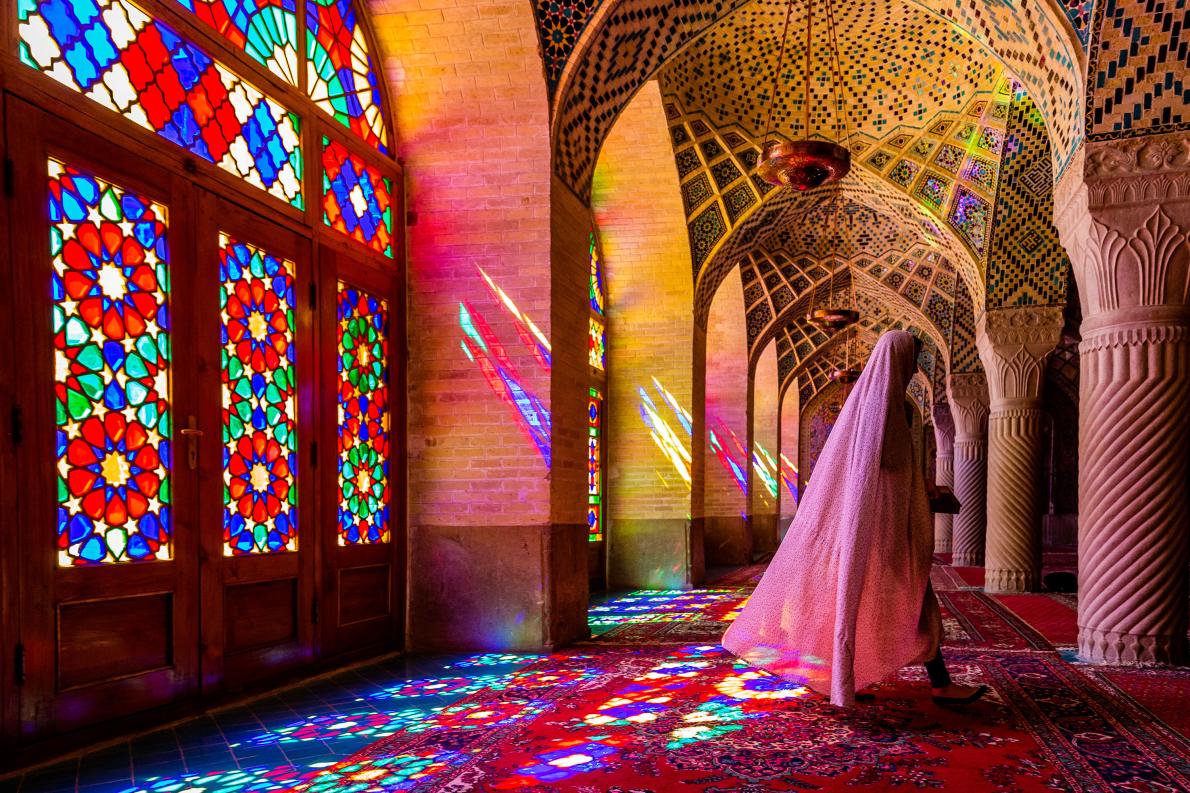Around a quarter of the entire population of Earth is Muslim. The ninth month of the Islamic calendar is called Ramadan, and is observed by Muslims around the world as a month of fasting to commemorate the first revelation of the Quran to Muhammad, according to Islamic belief. This year, in line with Ramadan, National Geographic published a photo gallery of the most beautiful mosques, the sacred places of Islamic worship, from around the world. Feast your eyes on these opulent architectural and cultural masterpieces as selected by Nat Geo, below.
Nasir Al Molk Mosque
Uncommon in mosques, the stained glass windows of Iran’s Nasir al Molk in Shiraz illuminate its Persian carpets with a kaleidoscope of patterned flecks of light.

Istiqlal Mosque
At the time of its construction in the late 20th century, Jakarta’s Istiqlal was considered avant-garde for its minaret and dome, considered “too Arabic” for the local Muslim population. Traditionally, Javanese mosques include a layered, triple-roof style.

Jama Masjid Mosque
India’s Jama Masjid features a red sandstone and marble exterior that pay homage to the Mughal empire, much of which was influenced by Persia.

Sultan Ahmed Mosque
Constructed during the early 17th century, Istanbul’s most photogenic building gets its nickname from the blue tiles adorning the interior.

Sheikh Zayed Grand Mosque
The massive Grand Mosque in Abu Dhabi holds more than 40,000 worshippers in its courtyard and prayer hall. The world’s largest Persian carpet stretches inside under German-imported chandeliers made with Swarovski crystals.

Sultan Hassan Mosque
Functioning as both a school and a mosque in Cairo for almost 300 years, Sultan Hassan provides an archetype mosque for experts to explain what Islamic philosophy is all about.
 Shah Mosque
Shah Mosque
One of the most celebrated characteristics of Iran’s Great Mosque of Isfahan is its expansion and development for more than 10 centuries, representing nearly a thousand years of Islamic art and architecture.

National Mosque of Malaysia
The roof of the National Mosque of Malaysia, built in capital Kuala Lumpur during the late 20th century, draws its inspiration from the underside of an open umbrella.

Education City Mosque
This mosque in Doha is elevated on five piers, that represent the five pillars of Islam – shahada (knowledge), salat (prayer), zakat (charity), siyam (fasting) and hajj (pilgrimage) – each engraved with Quranic verses in elegant calligraphy.

Hassan II Mosque
Hassan II Mosque’s nearly 700-foot minaret–the tallest in the world–is as iconic to Casablanca as the Empire State Building is to New York.

IBN Tulun Mosque
One of the best preserved mosques in Egypt, this majestic red brick complex was built in 876 by the Turkish governor of Egypt and Syria.

Suleymaniye Mosque
Ottoman mosques, like Istanbul’s Süleymaniye Mosque, intentionally imitate the church of Hagia Sofia, another major tourist site in the city.

Islamic Centre in Washington D.C.
The Islamic Center in Washington D.C. is celebrated for fusing together differing styles and cultural influences, particularly from Iran, Egypt, and Turkey.

Shah Faisal Mosque
Produced in the late 1970s, the Shah Faisal Mosque in Islamabad is a modern mosque that is Sunni in its practice, accomodating all of the rituals of the different denominations in the Muslim world.

The Great Mosque in Kairouan
The first Islamic city in North Africa and one of the four holiest cities for Muslims, Kairouan’s holy trifecta is complete thanks to the Grand Mosque of Kairouan, a structure in Tunisia admired for being an example of Islamic architecture of Muhammed’s house in Medina, considered the first mosque.
 Since the first ever mosque, in the home of the prophet Muhammed in Medina in Saudi Arabia, these exquisite holy places have proliferated across the globe. Mosques showcase a diverse range of style and design, but are identifiable through some key characteristics.
Since the first ever mosque, in the home of the prophet Muhammed in Medina in Saudi Arabia, these exquisite holy places have proliferated across the globe. Mosques showcase a diverse range of style and design, but are identifiable through some key characteristics.
First, a prayer hall with an ablutions area where worshippers can clean themselves before prayer. The semicircles in the wall of a mosque are called mihrabs, which indicate the direction of Mecca. There are minarets, or towers, from which the call to prayer is announced five times per day. And finally, mosques have domes that glow like orbs.
Next time you go travelling, make sure to count one of these architectural and cultural marvels into your journey.
Images sourced from National Geographic.

